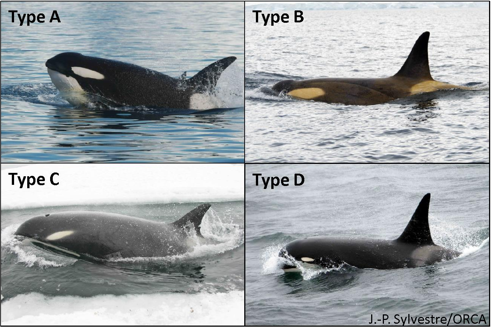Hunting Behavior in type a and type b Orcas
Biology 342 Fall 2014
Killer whales range the entire globe because of their adaptiveness to different varieties of prey, which they pass on to their offspring by means of culture, or “the transmission of learned behavior” (Marino et al., 2007). In order to pass on these learned behaviors to their offspring, cetaceans rely on imitation (Abramson et al, 2013, Guinet, 1991) and vocal and visual modes of communication (Marino et al., 2007). This section will provide a brief overview of the sensory mechanisms that allow for diverse communication, as well the brain that processes this communication and produces complex social behaviors.
Although the vocal behavior of the antarctic ecotypes has, at the time of this writing, not been studied, the ecotypes of the northeastern pacific have been extensively studied and, like the antarctic ecotypes, consist of mammal- and fish-specialist ecotypes. Because most marine mammals hear within the range of killer whales, the transient mammal-eating only produce significant amounts of vocal activity after a kill (Deecke et al., 2005). However, the antarctic ecotypes may be able to communicate more during hunting because their prey is located out of the water. In fact, Pitman and Durban report whales spy-hopping to detect seals on ice and, after detecting a seal, disappearing underwater presumably to communicate with other members of the groups because shortly after the rest of the group would appear around the ice floe and spy-hop as well (2012). More research is needed to determine if increased opportunities for vocalization enables the more coordinated hunting behavior of Type B orcas in the Antarctic.

Fig 3. Orca ecotypes around Antarctica. Note the very conspicuous eye patch of type B and A.
Killer whales have sharp vision out of the water (Pitman and Durban, 2012) and type B Orcas use this to their advantage to locate seals by spy hopping out of the water and visually searching for prey on the surface of the ice Smith et al., 1981). Additionally, the large, conspicuous eye patch of Type B killer whales (see figure 3), not present in all antarctic ecotypes, maybe “very useful for coordinating wave-washing behavior when groups swim rapidly in a tight synchronized formation” (Pitman and Durban, 2012).
The means by which killer whales are capable of cooperative and complex hunting techniques is their large brains; the brains of cetaceans are among the largest in absolute mass and relative to body size in the animal kingdom (Reidenberg, 2007). The large size may be due to “the requirements for effective functioning within a complex society characterized by communication and collaboration as well as competition among group members” (Reidenberg, 2007). Cetaceans have effectivexpanded insular and cingulate cortices, which is consistent with high-level cognitive functions in primates (Reidenberg, 2007). Additionally, cetaceans have a large number of large layer V spangle neurons, which were originally thought to be found only in humans and great apes (Reidenberg, 2007) and are associated with large brain size and complex social behavior (Allman et al., 2007). Social learning via imitation is thought to be indicative of complex cognitive processes (Zentall, 2006).
Website by Cecelia Erwin and Orian Evans for Reed College Biology 342: Animal Behavior.
Website design, content, research by Cecelia Erwin.
Content by Orian Evans.






